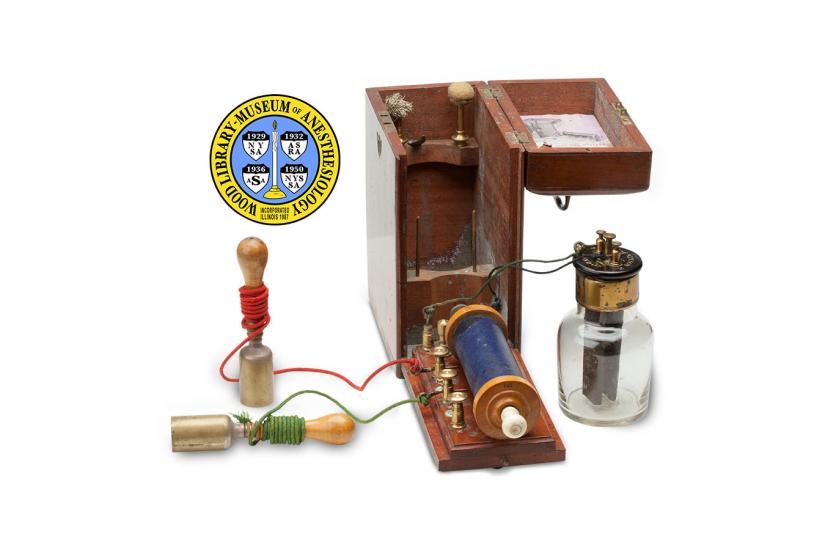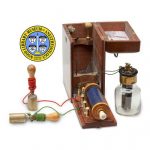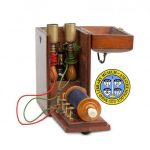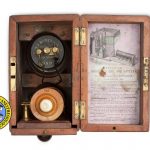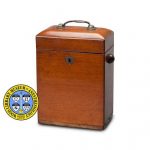Robinson Induction Coil & Battery
Since the 18th Century, electric shock has been administered in attempts to revive those whose heart or breathing has stopped. The first successful resuscitation by this means was performed in 1775. Almost 100 years later, in 1872, two men working independently described respiratory resuscitation by electrical stimulation of the phrenic nerve. This nerve runs from the neck to the diaphragm (the muscle that causes the lungs to expand during breathing). The French neurophysicist, Guillaume Duchenne (1806-1875) administered electro-phrenic stimulation to a drowning victim. The English surgeon, Thomas Green reported the resuscitation of patients who had succumbed to chloroform. It is thought that this success was also due to electro-phrenic stimulation.
The faradic battery shown here was made by T. J. Robinson, of London. Originally introduced in 1870, this is a later, "improved" model. Unlike many batteries that were marketed as a cure for diseases, this was intended to stimulate the phrenic nerve "for the resuscitation of patients in danger from the effects of chloroform."
Catalog Record: Robinson Induction Coil & Battery
Access Key: akwr
Accession No.: 2003-01-24-1
Title: Improved induction coil and battery for medical purposes.
Title variation: Alt Title
Title: Robinson induction coil and battery.
Title variation: Alt Title
Title: Robinson faradic battery.
Title variation: Alt Title
Title: Robinson improved induction coil and battery for chloroform overdose.
Publisher: London : T. J. Robinson, [between 1880 and 1900].
Physical Descript: 1 electric stimulation machine : wood, metals, glass, textiles, paper ; 20.5 x 40 x 35 cm.
Subject: Resuscitation – instrumentation.
Subject: Respiration, Artificial – instrumentation.
Subject: Electric Stimulation – instrumentation.
Note Type: General
Notes: The date range for the possible year of manufacture is based on dates found
for the address “338 Strand” and Helmet Court. The businessman listed at the
address in an 1880 publication is John Jones. This is the same name found for
the address in a number of publications from the 1860s and 1870s. The next
publication found with that address is a 1883 directory, and “Robinson, T.J.
electrical instrument maker” is listed at the address. in a 1885 directory,
“Robinson, Thomas James,” is listed at the address. The next publication (a
directory) with that address was published 1900. It listed “Robinson, A. & P”
at the address.. A 1991 directory also lists “Robins, Arthur & Perky” at the
address. The first version of the device was likely manufactured by Schmidt
and Robinson (see Inventions, Brit Med J, 1870, and Richardson, 1870). The
date range could change if documentation indicates the range should be
corrected.
Note Type: Citation
Notes: Althaus J. A Treatise on Medical Electricity Theoretical and Practical and
Its Use in the Treatment of Paralysis, neuralgis, and other diseases. 2nd ed.
London: Longmans, Green, and Co.; 1870. https://books.google.
com/books?id=1iBFAAAAcAAJ&printsec=frontcover#v=onepage&q&f=false. Accessed
August 31, 2014. [An example of electrical therapies and how the device here
and similar devices were used.]
Note Type: Citation
Notes: Inventions … : Galvanic apparatus. Brit Med J. February 5, 1870;1:136.
[Messrs. Schmidt and Robinson, of 267, Strand, have submitted to our
inspectio a galvanic machine which appears to answer all the purposes for
which it was originally intended—that of the resuscitation of patients in
danger from the effects of chloroform, and equally so for general use,
wherever it is desired to employ electricity for medical purposes.”]
Note Type: Citation
Notes: Jones, John, 338 Strand, W.C. (4) [in list of members]. In: Society for the
Encouragement of Arts, Manufactures, and Commerce. [London]: [George Bell and
Sons]; December. 1880:22. https://books.google.
com/books?id=Dhw_AQAAMAAJ&printsec=frontcover#v=onepage&q&f=false. Accessed
August 27, 2014.
Note Type: Citation
Notes: Richardson BW. On death from chloroform. Brit J Dent Sci. November,
1870;13(173):520. https://books.google.
com/books?id=ZfwaAQAAMAAJ&printsec=frontcover#v=onepage&q&f=false. Accessed
August 31, 2014. [Includes an image of what appears to be the same device as
described in this record.]
Note Type: Citation
Notes: Robinson, A. & P, Medical Battery Manufacturers, 3, Helmet-court, Strand,
London, W.C. [directory entry]. “The Electrician” Electrical Trades’
Directory and Handbook for 1900. London: George Tucker; 1900:683.
Note Type: Citation
Notes: Robinson Thomas James, Helmet court, 338 Strand w c & 2 Addington crescent,
York rd. Lambeth se [directory entry]. In: Kelly’s Directory of Chemists and
Druggists. 5th ed. London: Kelly and Co.; 1885:378. https://books.google.
com/books?id=6OgNAAAAQAAJ&printsec=frontcover#v=onepage&q&f=false. Accessed
August 27, 2014.
Note Type: Citation
Notes: Robinson, T.J., electrical instument maker, Helmet-court, 338, Strand, London
W.C. [directory entry]. In: J. A. Berly’s British, American and Continental
Electrical Directory and Advertiser. London: Dawson & Sons; 1883:249.
https://books.google.
com/books?id=1vewAAAAMAAJ&printsec=frontcover#v=onepage&q&f=false. Accessed
August 27, 2014.
Note Type: Citation
Notes: Rockwell AD. The Medical and Surgical Uses of Electricity. New York: William
Wood and Company; 1896. https://books.google.
com/books?id=XDwXAQAAMAAJ&printsec=frontcover#v=onepage&q&f=false. Accessed
August 31, 2014. [An example of electrical therapies and how the device here
and similar devices were used.]
Note Type: Citation
Notes: Waring EJ. In: Practical Therapeutics, Considered chiefly with Reference to
Articles of the Materia Medica. 2nd London ed. Philadelphia: Lindsay &
Blakiston; 1866:210-211. https://books.google.
com/books?id=Fs-79mFlYnYC&printsec=frontcover#v=onepage&q&f=false. Accessed
August 27, 2014.
Note Type: Physical Description
Notes: One early device for “medical electricity”; The dimensions in the physical
description field are just one possibility for the space required to display
the device in an exhibit; With all of the parts tucked into the wooden case
it measures approximately 24 x 18 x 10.2 cm; A handle is located on the lid;
The right side of the box is hinged to the base and can fold outward as a
base for the induction coil and adjustment knobs for the coils and
electrodes; The adjustment knobs are marked “P” and “S” and a smaller “N”;
Also in the case is a is a glass bottle for the batteries aqueous solution of
“Bichromate of Potash”; On the lid of the bottle are manufacturer markings,
“T. J. ROBINSON [new line] Helmet Ct [New line] 388, Strand [new line]
London”; Two textile covered wires connect the top of the bottle to the base
of the coil; One is marked “P” on both the base and the top, and the other is
marked “N”; The wooden handles for the electrodes have two open cylindrical
like attachments, one sponge toped electrode, and one metallic brush; A paper
label is inside the lid: Text on the paper includes, “IMPROVED [new line]
INDUCTION COIL AND BATTERY, [new line] FOR [new line] MEDICAL PURPOSES, [new
line] DIRECTIONS FOR USE. The coil and battery being connected as shewn in
the engraving push down the sliding rod on the top of battery until the Zinc
is SLIGHTLY IMMERSED. As the solution becomes exhausted the Zinc must b
lowered, but never more than sufficient to work the coil and always drawn up
after using it. [new paragraph] By moving the screw of contact breaker the
rapidity of the shocks can be regulated with the greatest nicety, and “when
screwed up, so as only to produce a humming sound, the shocks are so rapid as
to be almost continuous. [New paragraph] When the conductors are places in
the bindscrews with P between, the primary current is received, when in those
with S the secondary, and when in the two end ones and the bent wire in the
??? ?????? ????, both currents are brought into play, [i.e.] the greatest
power of the machine. [new paragraph] The power is regulated by moving in or
out the slide with knob in centre of coil, the current being strongest when
the slide is out. The conductor covered with sponge is for the Phrenic nerve
in cases of accident from chloroform, and the brush for Faradisation, they
both screw on to the wood handles with the flexible conductors. [new
paragraph] When the P and N on battery are connected to the P and N on the
base coil, the current issues from P and returns through N of hand
connections. [new paragraph] The primary and combined currents are
uni-currents, the secondary a bi-current. [new paragraph] BATTERY SOLUTION.
[new line] Dissolve 1 part bichromate of potash in 8 parts boiling water,
when cold add 1 part suphuric acid all by weight.”; A greenish coating,
possibly from corrosion, lines the base and the sides of the wooden box; The
box is fragile and should be move carefully.
Note Type: Reproduction
Notes: Photographed by Mr. Steve Donisch, September 18, 2013.
Note Type: Historical
Notes: In the late 18th century, many Western European countries were forming
organizations and processes for reviving people who were ‘apparently dead,’
such as persons who had drowned. During this time, scientists also began to
consider the possibility of electrically stimulating the body to induce
breathing. Later, in the 19th century, a number of scientists and physicians
reported using electricity to successfully resuscitate people who had stopped
breathing due to adverse effects of chloroform.
The nerve they were stimulating, the phrenic nerve, is responsible for
delivering signals to the diaphragm, which is the major breathing muscle
located across the bottom of the chest. When the diaphragm is stimulated and
contracts, air is drawn into the chest, and when the diaphragm relaxes, air
is released from the chest.
The electrical device described here came with a sponge covered electrode
that was specifically for the stimulation of the phrenic nerve in patients
who ceased breathing due to chloroform. It also came with hand-held
electrodes and a small wire brush, which were used for various electrical
therapies of the time. (See the catalog record for the Magneto-Electric
Machine for more information.)
The stimulation of the phrenic nerve for artificial respiration eventually
fell out of favor. However, during the mid-20th century a few clinical
researchers began again the study and development of devices that prompt
breathing by phrenic nerve stimulation. These devices, sometimes called
breathing pacemakers, are occasionally used in very specific circumstances
and can be an alternative to long term ventilator support.
Note Type: Publication
Notes: Allsop FC. Electrical apparatus: constructing and repairing. Engl Mechanic
World Sci. July 28, 1893;57(1479):507-509. https://books.google.
com/books?id=rIQAAAAAMAAJ&printsec=frontcover#v=onepage&q&f=false. Accessed
August 31, 2014.
Note Type: Publication
Notes: Horne JH. A Guide to the Correct Administration of Medical Galvanism. 2nd ed.
London: Horne, Thornthwaite, and Wood; [1847?]. https://books.google.
com/books?id=pn5ZAAAAcAAJ&printsec=frontcover#v=onepage&q&f=false. Accessed
August 27, 2014.
Note Type: Publication
Notes: Norrie HS. Induction Coils: How to Make, Use and Repair Them. 2nd ed. New
York: Spon & Chamberlain; 1901. https://archive.
org/details/inductioncoilsho00schn. Accessed August 27, 2014.
Note Type: Publication
Notes: Reynolds Dv. A brief history of eletrotherapeutics. In: Reynolds Dv, ed.
Neuroelectric Research. Springfield, Illinois: Charles C. Thomas Publisher;
1971:5-12.
Note Type: Publication
Notes: Watteville A. A Practical Introduction to Medical Electricity. New York: J. H
Vail & Company; 1884. https://books.google.
com/books?id=zop1nv3uQ5YC&printsec=frontcover#v=onepage&q&f=false. Accessed
August 27, 2014.
Note Type: Exhibition
Notes: Selected for the WLM website.
